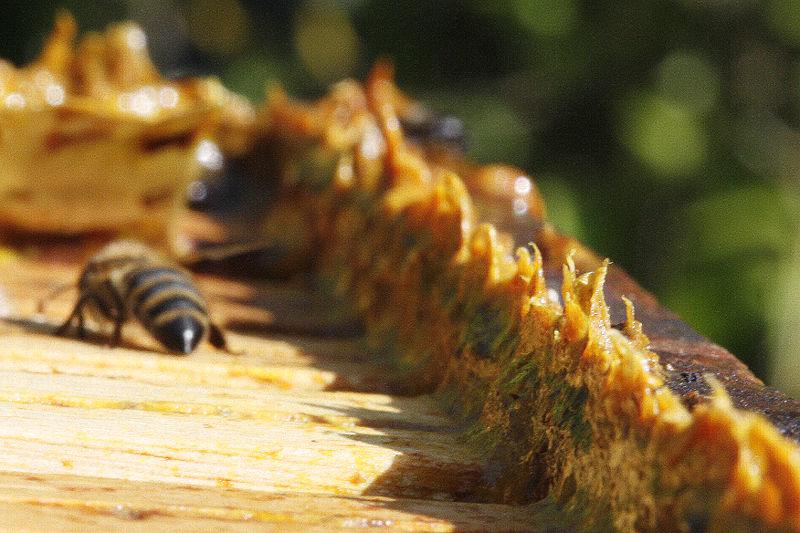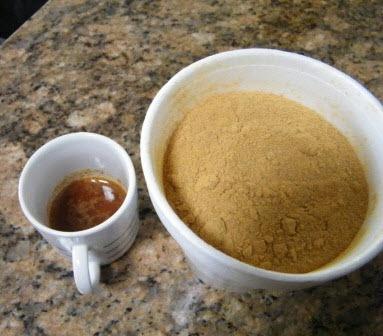دنج
دنج
دنج
دنج
ما هو دنج؟
1. هيكل دنج
دنج .
إنها مادة لزجة ، صلبة وهشة عند درجة حرارة 15 مئوية ، ناعمة وقابلة للانحناء عند 30 درجة مئوية ، والتي يمكن تغييرها من الأسود إلى الأصفر حسب أصلها.

على الرغم من أن هيكل دنج الخام يختلف اختلافا كبيرا وفقا لمصدره. 50-55 ٪ راتنج وبلسم ، 20-35 ٪ شموع مشتقة من النباتات ، 10-15 ٪ من الزيوت الأثيرية والزيوت الأساسية ، 2-5 ٪ حبوب اللقاح ، كميات صغيرة من المركبات العضوية وغير العضوية. في تقرير آخر ، يحتوي البروبوليس على 46٪ بلسم و 27٪ شمع نباتي و 15٪ فلافون وفلافونويد.
إنها مادة لزجة ، صلبة وهشة عند درجة حرارة 15 مئوية ، ناعمة وقابلة للانحناء عند 30 درجة مئوية ، والتي يمكن تغييرها من الأسود إلى الأصفر حسب أصلها.

على الرغم من أن هيكل دنج الخام يختلف اختلافا كبيرا وفقا لمصدره. 50-55 ٪ راتنج وبلسم ، 20-35 ٪ شموع مشتقة من النباتات ، 10-15 ٪ من الزيوت الأثيرية والزيوت الأساسية ، 2-5 ٪ حبوب اللقاح ، كميات صغيرة من المركبات العضوية وغير العضوية. في تقرير آخر ، يحتوي البروبوليس على 46٪ بلسم و 27٪ شمع نباتي و 15٪ فلافون وفلافونويد.
دنج النحل الحور والبلوط والزان والأوكالبتوس وأشجار السنط والصنوبر ، وخاصة من مختلف الأشجار والشجيرات والنباتات جمع. يمكن تفريغ البروبوليس الذي تحمله ساقه الخلفية للنحلة واستخدامه عند الضرورة بمساعدة النحل الآخر.
2. Collection of Propolis from the Hive
The bees accumulate propolis in the hive behind the bottom board, the frame edges and the entrance hole. Propolis collected here can be scraped off. The scraping propolis thus obtained may not be clean and may contain different residues.


Therefore, in the technical collection of propolis, plastic plates similar to the queen grid placed on the frames or openings in the front and rear hull boards of the hive are used. After the propolis is deposited in the collecting plate, the propolis is easily harvested from the plate and packaged by hand when the plate is kept in a cold environment for a while. From the harvested crude propolis, "Soft Propolis Extract" is produced in the laboratory.
3. Uses of Propolis
Propolis by bees in hives; It is used for covering the cracks and bursts in the hive, adhering the frames to the walls of the hive and to each other, preventing the embalming and stinking of the pests that enter the colony and cannot be thrown out of the colony, polishing and polishing the honeycomb cells and sterilizing the hive. .


Content of Propolis:
Propolis is a substance that is resinous and wax-like, collected from the buds and bark of trees by bees. Its color and physical properties vary according to its source and are used by bees in the hive for various purposes.
PROPOLIS QUALITY
Propolis is stone hard when removed from the hive. In this case, it contains 40 percent wax, 15-20 percent dust and other residual materials. There can be two ways of preparing for use following the exit from the hive:


1-Resinous Powder Form:
It is crystallized by holding in a deep freeze and then drawn into a crusher machine to make powder.
Propolis Extract 2:
The first propolis is treated and distilled to remove wax and other materials. In addition, purification process is continued based on the active ingredients.
Propolis extract is thus produced. Extracts of various purities ranging from 70 percent purity to 96 percent purity can be obtained.
The quality category is determined by taking into account the purity and active ingredient ratios in the propolis extract. It can be 3 to 7 times more effective with its purity and content (compared to propolis taken).
Conditions of use and storage conditions:
Store at room temperature.
Propolis retains its nutritional value and properties for 18 months at room temperature.
Dosages for use:!
For general use, 2 grams of propolis extracts can be taken as a daily dose.
For children, a daily dose of 250 mg (1-3 in teaspoon) between 1-3 years of
age is one-quarter (500 mg) of teaspoon (500 mg) between 3-6 years of age, and a daily dose of up to 12 years of age and adult doses over 12 years of age. available.

age is one-quarter (500 mg) of teaspoon (500 mg) between 3-6 years of age, and a daily dose of up to 12 years of age and adult doses over 12 years of age. available.

Uses:
Consumption and use in water: For oral health, a liquid can be gargled with this liquid by placing a teaspoon of the extract in half a liter of water. One sip of the same liquid in the morning and evening can be taken again. This liquid can be consumed by joining drinks such as coffee or juice.
Use of extract in powder form:
According to taste, the dose of propolis can be taken directly by adding honey or yogurt.
Propolis can be used by mixing 75 grams of honey, 5 grams of propolis extract and 20 grams of warm water.
Honey-bee milk-pollen-propolis mixture: 1 kg honey 200 grams of royal jelly, 200 grams of pounded pollen, 50 grams of propolis extract can be consumed by adding summer-winter, can be prepared .
The taste of the pure form of propolis in powder form or in extract form is not appreciated by children. We can give our children by mixing in honey as given above, or there may be other mixtures that they will enjoy.
For example molasses-yogurt-propolis or jam-propolis-bread.
,
,
Side effects
No side effects have been observed, but their use is far above recommended doses. ..
Propolis is not a medicine but a food supplement.
Propolis is not a medicine but a food supplement.
Tag: propolis , what is propolis, propolis drop, propolis drop , genuine propolis, organic propolis , anzer propolis, propolis drop, damages of propolis, benefits of propolis, what is good in propolis, what is propolis, how is propolis produced, how to use propolis, what is propolis, benefits of propolis, instructions for use of propolis, propolisdamla, propolis pulus ,



